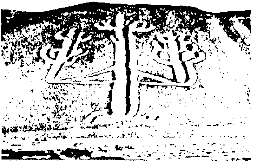THE CANDELABRA OF THE ANDES or the PARACAS CANDELABRA
One of the most engimatic giant ground drawings (or "geoglyphs")
in South America is seen best from several miles out at sea. Etched
into a sloping hill at Pisco Bay on the Peruvian coast, this strange
figure looks vaguely like a candlestick; thus, its name "The
Candelabra of the Andes." The Candelabra is 595 feet long
and can be seen from as far as 12 miles out to sea. Pottery found
near the figure has been carbondated at 200 BC and is assignable
to the Paracas Culture. Separated by 130 miles from the Nazca
Plain, with its famed giant figures, the Candelabra apparently
is not the work of the Nazca people. It is puzzling why that such
a figure would be placed where it could be seen best by sailors.
As with Costa Rica's stone spheres, the Candelabra's makers, purpose,
and symbology are in doubt. The Pisco geoglyph really doesn't
match the motifs in our books on South American archeology. Some
archeologists say it is only a trident, but who ever saw a trident
like this? F. Joseph, the author of the present article, thinks
it looks like a Jimson weed! Furthermore, he states that there
is a miniature version of the Candelabra drawn on a rock in California's
Cleveland National Forest. Joseph associates the two candelabras
in this way: The ancient inhabitants of Peru voyaged to California
to collect Jimson weed and other hallucinatory drugs. When they
sailed back to Peru with their cargo, they used the Pisco geoglyph
as a navigational aid!



(Joseph, Frank; "The Candelabra of the Andes," The Ancient American, 2:10, no. 10, 1995.)
Situated 120 miles north west of nazca is one of the largest of all geoglyphs the 700ft high trident on the mountain side at the bay of Paracas. This mysterious geoglyph is etched into the ground to a depth of around 2 feet, and outlined by stones which may have been placed at a later date. No-one knows for certain the age of the original carving. However, an expedition by the French writer Robert Charroux in 1969, noted that, although the mountainside was exposed to the wind, the wind contained no dust or sand. Chatroux thus concluded that the trident carving could have been drawn millennia ago and yet still have avoided any significant erosion. The trident symbol at Paracas is a major clue to its origin. According to local legend, this carved trident represents the lightning rod of the god Viracocha, who was worshipped throughout South America.